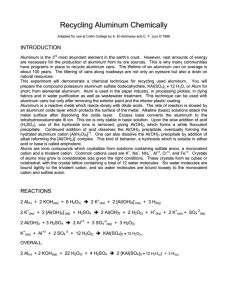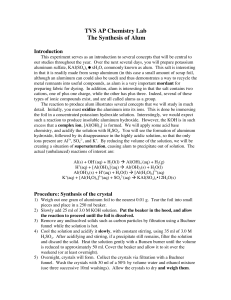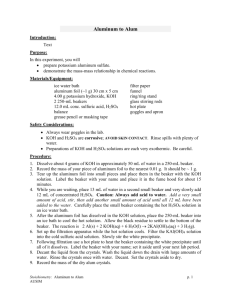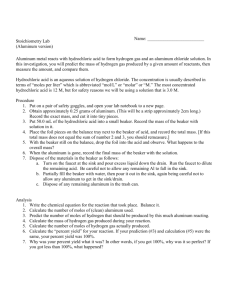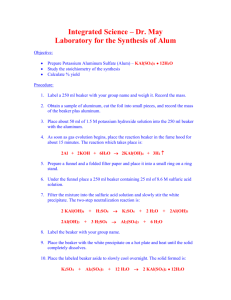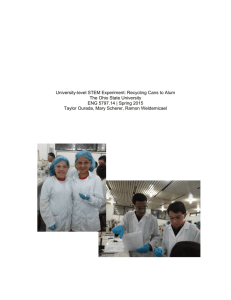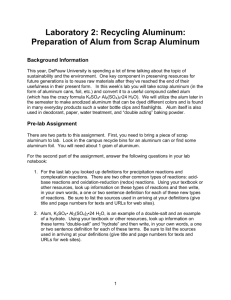Recycling Aluminum Chemically
advertisement
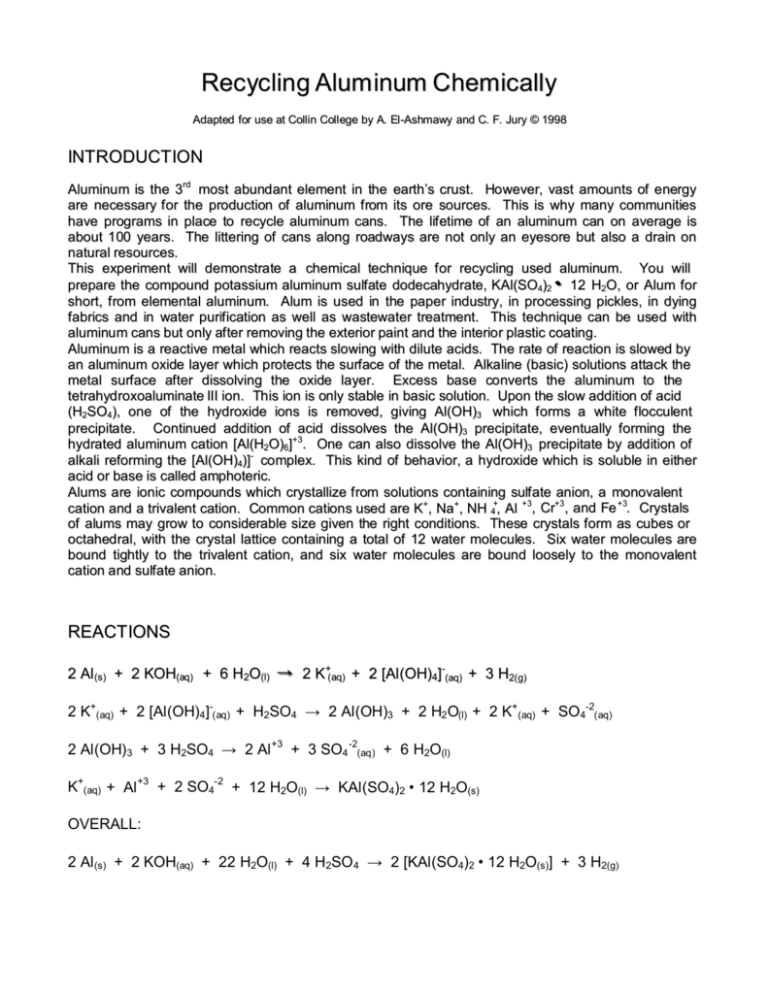
Rec yc ling Alum inum Chem ically Adapted for use at Collin Coll ege by A. El -Ashmawy and C. F. Jury © 1998 INTRODUCT ION Aluminu m is the 3rd most abund ant element in the earth’s crust. Ho wever, vast amounts of e nergy are necessary f or the production of aluminum f rom its ore sources. This is why many communities have programs in place to recycle aluminum cans. The lif etime of an aluminum can on average is about 1 00 years. The littering of cans along roadways are not only an eyesore but also a drain on natural resources. This experiment will demonstra te a chemical technique f or recycling used aluminum. Yo u will prepare the compound potassium aluminum sulfate dodecahydrate, KAl(SO4)2 •• 12 H2O, or Alum for short, f rom elemental aluminum. Alum is used in the paper industry, in processing pickles, in dying fabrics and in water purif ication as well as wastewater treatment. Th is technique can be use d with aluminu m cans but only af ter removing the exterior paint and the interio r plastic coating. Aluminu m is a reactive metal which reacts slowing with dilute acids. The rate of reaction is slowed by an aluminum oxide layer which p rotects the surface of the metal. Alka line (basic) solutions atta ck the metal surface after dissolving the oxide layer. Excess base co nverts the aluminum to the tetrahyd roxoaluminate III ion. Th is ion is only stable in basic solution. Upon the slow addition of acid (H2SO4), one of the hydroxide ions is removed, giving Al(OH)3 which f orms a white f locculent precipita te. Continued addition of acid dissolves the Al(OH)3 precipitate, eventually forming the hydrated aluminum cation [Al(H2O)6]+3. One can also dissolve the Al(OH)3 precipitate by add ition of alkali reforming the [Al(OH)4)]- co mplex. This kind of behavior, a hydroxide which is soluble in either acid or base is called amphoteric. Alums a re ionic compounds which crystallize f rom solutions containing sulf ate anion, a monovalent cation and a trivalent cation. Common cations used are K+, Na+, NH 4+, Al +3, Cr+3, and Fe +3. Crystals of alums may grow to considerable size given the right conditions. These crystals form as cubes or octahed ral, with the crystal lattice containing a total of 12 water molecules. Six water molecules are bound tightly to the trivalent cation, and six water molecules are bo und loosely to the mono valent cation a nd sulfate anion. REACT IONS 2 Al (s) + 2 KOH(aq) + 6 H2O(l) → → 2 K+(aq) + 2 [Al (OH)4]-(aq) + 3 H2(g) 2 K+(aq) + 2 [Al(OH)4]-(aq) + H2SO4 → 2 Al(OH)3 + 2 H2 O(l) + 2 K+(aq) + SO4-2(aq) 2 Al(OH)3 + 3 H2SO4 → 2 Al +3 + 3 SO4 -2(aq) + 6 H2O(l) K+(aq) + Al +3 + 2 SO4-2 + 12 H2O(l) → KAl(SO4)2 • 12 H2O(s) OVERALL: 2 Al (s) + 2 KOH(aq) + 22 H2O(l) + 4 H2SO4 → 2 [KAl(SO4)2 • 12 H2O(s)] + 3 H2(g) P ROC E DU RE (W ork in a fume hood) 1. W eigh approximately 1g of Al metal & place in a 250mL beaker. 2. Add 25mL 2.8M Potassium Hydroxide (KOH) to the beaker. W hat h appened? 3. After f ive minutes, place the beaker on a hot plate & heat the reaction mixture GENTLY. 4. If the liquid level in the beaker drops to half the original volume, add deionized water to mainta in the volume. Do not let the bea ker dry out! W hat color is the reaction? 5. Heat the reaction until the reaction is complete. How will you know when this happens? 6. W hile the solution is HOT, it must be vacuum f iltered to remove any undissolved materials. Th is is done using an aspirator and Buchner f unnel system. Be sure your apparatus is securely clamped. Have the instructor check it before completing the f iltration. W hat’s on the f ilter paper? W hat color is the f iltrate? 7. Rinse the reaction beaker 2x with 5mL portions of deionized water, pouring each rinse through the f ilter. 8. Tran sf er the f iltrate to a clean 250mL beaker. Rinse the f ilter f lask with a 10mL portion of deion ized water. Add this to the f iltrate. 9. Cool the solution, slowly and carefully. 10. W hen the solution is cool, W ITH STIRRING add 20mL 9.0M Sulfuric Acid (H2SO4). Any observations? 11. If the solution is not clear, wa rm the solution GENTLY until it clears up. W hat sp ecies does this solution contain? Can you name them? (Hint: See equations on previou s page) 12. Prepare an ice water bath by f illing a 600mL beaker half full of crushed ice, just covered with water. 13. Place the 250mL beaker containing the f iltrate in the ice bath. Allow to cool for 15 minutes. W hat is happening in the bea ke r? 14. W eigh a piece of filter paper. Clean and reassemble the vacuum f iltration apparatus using the weighed f ilter paper. Filter your mixture. 15. Prepare an ethanol-water rin se by mixing 12mL ethanol with 12mL deionized water. Cool th e rinse solution in the ice water bath for a few minutes. Rinse any so lid which may be on the f ilter. App ly vacuum suction until a ll crystals are dry. 16. Allo w any remaining product to air dry. 17. W eigh the alum crystals. 18. Sho w product to your instructor, the f ollow their instructions for storing your product (if needed). RE P ORT — Rec yclin g Al um inum Chemicall y Name: __________ ____________ ___ ____ Class/Section: ______ ____ ____ Data / Obs ervations 1. Mass of Al : _______________ 2. Al + KOH Observati ons (what col or?): _________________________________________________________________________ 5. Reacti on i s compl ete when _________________________________________________ 6. (a) Vacuum fil trati on apparatus checked by i nstructor ________ (b) On Fil ter Paper: ______________________________________________________ (c) Col or of Fil trate: ______________________________________________________ 17. Mass of Al um: _______________ 18. Al um shown to i nstructor: ________ Calculations (Sho w ALL work on the b a ck of this sheet) Mass of Al : _______________ Mol es of Al : _______________ Stoichiometry ratio (Alum:Aluminum): _______________ Moles of Al um produced: _______________ Mass of Al um produced: _______________ Theoreti cal yiel d of Alum: _______________ Percent yi el d of Al um: _______________
